|
The Pony Express Stations of Utah in Historical Perspective
|

|
THE STATIONS (continued)
Government Creek (Davis Station, Government Well)
Utah No. 16 (Non-contract)
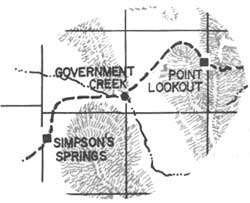 |
Location: SE1/4SE1/4 Section 25, Township 8 South, Range 8 West, Salt Lake Meridian.
Eight miles from Point Lookout.
There is some doubt as to whether the structures at this location were used by the Pony Express. There is record of the army digging a well here for an outpost, and it was mentioned in an interview with one of the stage drivers in the Salt Lake Tribune. [34]
A telegraph station was established here in late 1861 and operated by David E. (Pegleg) Davis (See Photo 21). Its location is reflected on the 1875 cadastral plat (See Figure 21). The transcontinental telegraph was in operation through this area until 1869 when it was moved north to parallel the new transcontinental railroad.

|
| Figure 21. Government Creek T. 8 S., R. 8 W. Sec. 25 1875 Survey. (click on image for a PDF version) |

|
| Photo 21. Government Creek telegraph station (Courtesy of the Utah State Historical Society). |
Government Creek Station is neither mentioned in the 1861 contract nor in Egan's book. Until appropriate investigations are complete, questions will remain to plague the researcher. Why is there such a gap between Point Lookout and Simpson Springs when a mountain pass exists and on either side; stations are spaced about eight miles apart? Why build a telegraph station here when a spur line could have been built to O.P. Rockwell's (Porter Rockwell's ranch was just a short distance to the south and a similar spur was used at Deep Creek to Egan's Ranch)? Why was a telegraph station built here when at Point Lookout or Simpson Springs conditions for grounding the single wire were better (more moist the soil the better the ground).
The logic of building a telegraph station at Government Creek bears a closer look. A single wire telegraph would carry as far as 250 miles (with enough batteries) so that booster stations in between were not necessary. Davis Station is about 80 miles from Salt Lake and about 100 miles from Deep Creek. Therefore, technically, placement at this location was not necessary. Also telegraph stations could be spliced in anywhere along the line with the use of a lead wire from the main line to a sounder, two batteries, a key, and a ground wire. [35] Was there any reason for establishing a telegraph station here at all unless the buildings were already present? This suggests, therefore, that the buildings were already there and possibly used by the Express. The foundations of two structures remain evident at the site (See Photo 22).
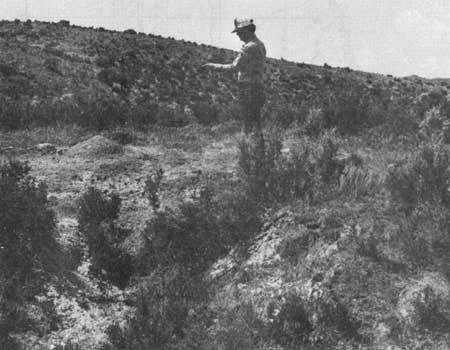
|
| Photo 22. Government Creek Station site (BLM photo 1978). |
Simpson Springs (Pleasant Springs, Egan's Springs, Lost Springs)
Utah No. 17 Contract Station
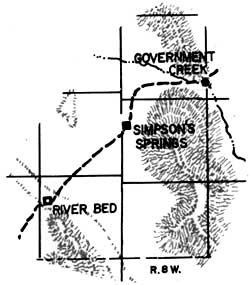 |
Location: SW1/4NE1/4 Section 18, Township 9 South, Range 8 West, Salt Lake Meridian. Eight miles from Government Creek. Simpson Springs became one of the most prominent stations in the West Desert due to the availability of excellent water. Chorpenning, living in a Sibley tent (See Figure 22) first developed the area in 1851. A permanent structure was constructed, with others soon to follow. Chorpenning's buildings were probably used by the Overland Mail and the Pony Express. The 1873 survey plat places the Express station about 300 feet west of the present reconstructed building (See Figure 23). Probably more than one structure was utilized for the Express and stage at the location; depending upon the operator's preference for family housing. Aerial remote sensing, using infrared film, shows what might be the location of a structure just north and east of where the springs originally flowed and west of the present reconstruction. |

|
| Figure 22. Sibley Tent. |

|
| Figure 23. Simpson's Springs. T. 9 S., R. 8 W. Sec. 18 1873 Survey. (click on image for a PDF version) |
After demise of the Pony Express and the Overland Mail activities, Simpson Springs utilization decreased. It wasn't until the 1890's when mining activities around Gold Mill increased that Simpson Springs again became a popular trail stop. The rock station was refurbished and used by the Walters and Mulliner Stage Co. [36] BLM's reconstruction of the building is based on oral accounts and excavations (See Photo 23). The work under BLM direction, was completed in 1975 by the Future Farmers of America.
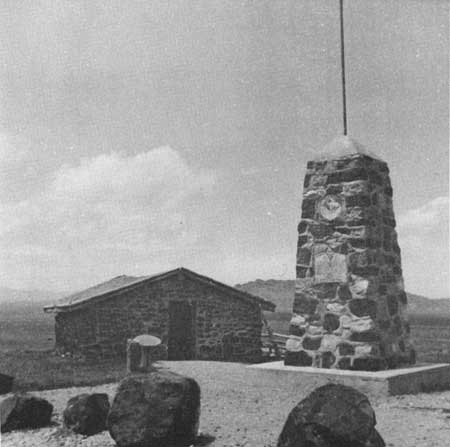
|
| Photo 23. Reconstructed Simpson Springs Station (BLM photo 1978). |
In the 1890's several other buildings were also constructed including the Dewey and Clara Anderson home destroyed by fire about 1957 (See Photos 24 & 25). According to an informant, Clara Wright Anderson died during childbirth either while the house was being constructed or shortly thereafter. That date was May 14, 1895. [37] Other buildings existed in the area including a log grocery store (See Photo 26) apparently located southeast of the Anderson home.

|
| Photo 24. The old Anderson home at Simpson Springs, photographed in 1953 (Courtesy of Dr. Eric E. Simonson). |
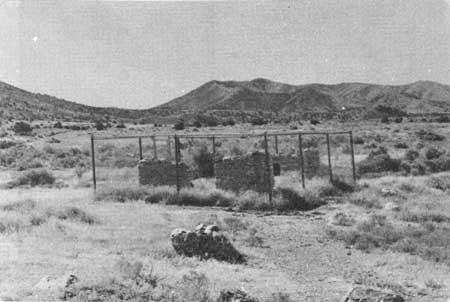
|
| Photo 25. The stabilized Anderson home today (BLM photo 1978). |
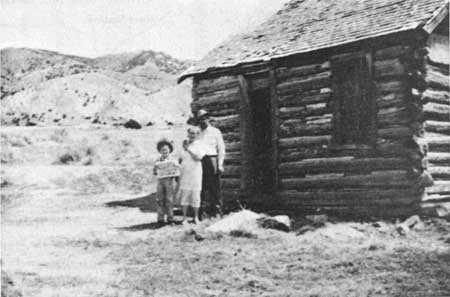
|
| Photo 26. Log structure photographed at Simpson Springs in the 1950's (Courtesy of John Carlson). |
A Civilian Conservation Corp (C.C.C.) camp was built west of the site in the 1930's; its remnants are evident today. BLM has developed the area and installed camping and interpretive facilities.
Riverbed
Utah No. 18 Contract Station
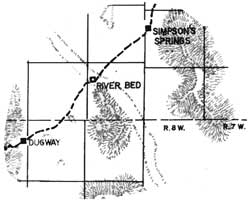 |
Location: NE1/4NE1/4 Section 18, Township 10 South, Range 9 West, Salt Lake Meridian (See Figure 24).
Eight miles from Simpson Springs.
The station was built in an old riverbed formed by evaporation of Lake Bonneville. The water contained in the northern portion of the great inland sea had a greater surface than the southern portion. Consequently more evaporation occurred in the northern part. Water seeks its own level and in this case, the water was squeezed into a low channel between two mountain ranges on the east and west. Here the movement of the water from south to north dug the river as the lake receded.
Because of flash flooding, little evidence today remains of the station's existence. [38] Based on an early photograph, the authors furnish a rendering of the structures located at the Riverbed Station complex (See Figure 25). Also, a recent photograph was taken from about the same location as the original (See Photograph 27). It is mentioned that it was hard to keep a station keeper at Riverbed because the area was supposedly haunted by "desert fairies." [39] A monument was established at the site by the Civilian Conservation Corp in 1939 or 1940.

|
| Figure 24. River Bed T. 10 S., R. 9 W. Sec 18 1875 Survey. (click on image for a PDF version) |

|
| Figure 25. River Bed Station |
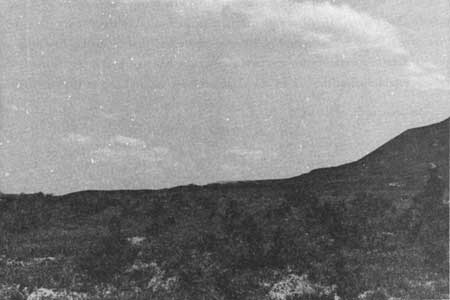
|
| Photo 27. Site of Riverbed Station; looking south (BLM photo 1978). |
Dugway (Dugout)
Utah No. 19 Contract Station
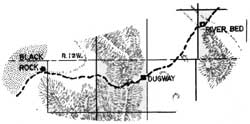 |
Location: SE1/4SW1/4 Section 13, Township 11 South, Range 11 West, Salt Lake Meridian.
Ten and one-half miles from Riverbed.
Water for Dugway Station had to be hauled from Simpson's Springs. Although three wells were dug over several years, one reaching a depth of 120 feet, no water was found. Noted as a "substation" by Horace Greeley, [40] nothing very permanent was ever constructed at the site. In 1860 a shelter was placed over a dugout and an adobe chimney installed. [41] In the 1890's, the location was utilized as a halfway stop by the Walters and Mulliner Stage Co. on the route between Fairfield and Ibapah. [42] A monument is located at the site today (See Photo 28). Physical evidence at the station site is limited to a disturbed area containing poorly preserved metal objects (possibly from a corral or blacksmithing area north of the wash) and some concentrated stone.
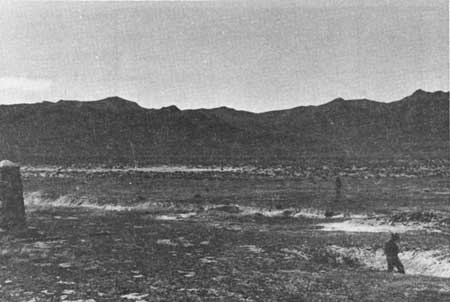
|
| Photo 28. Site of Dugway Station; looking southwest (BLM photo 1978). |
Blackrock (Butte, Desert Station)
Utah No. 20 Non-contract
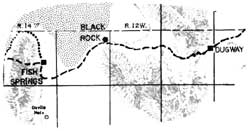 |
Location: NW1/4SE1/4 Section 12, Township 11 South, Range 12 West, Salt Lake Meridian.
Thirteen and three-quarter miles from Dugway.
The authors have not located the site of Blackrock Station. Reconnaisance and infrared photographs have also failed to produce any evidence. Only a vandalized monument marks its general location. Initially called Butte or Desert Station, the rock structure was constructed as part of trail improvements undertaken by the Overland Mail Company after acquiring the Express in July 1861. [43]
Informants say the station site lies west and north of the volcanic outcrop known geographically as Blackrock [44] (See Photo 29). The old Lincoln Highway (1913-1927) first encountered and utilized the old Overland Route about one-quarter mile east of the monument. This routing was used as an alternate to the main road during wet weather.
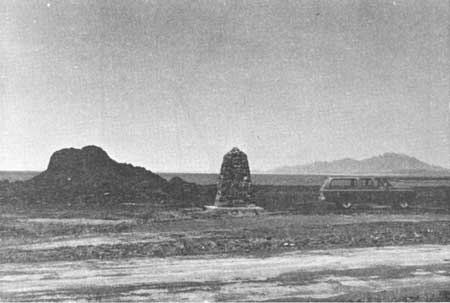
|
| Photo 29. Site of Blackrock Station. The trucks location may mark the station site (BLM photo 1978). |
| <<< Previous | <<< Contents>>> | Next >>> |
ut/2/sec2c.htm
Last Updated: 18-Jan-2008